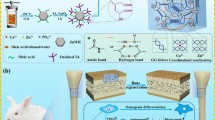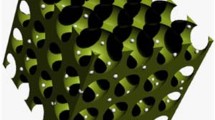Abstract
To evaluate the bone regeneration capacity of Zn–2Ag–0.04Mg alloy scaffold in vivo. Zn, Zn–2Ag and Zn–2Ag–0.04Mg scaffolds were implanted in the femur of New Zealand rabbits, and the degradation of the scaffolds and the regeneration of the bone were observed at 6th week and 6th month. Two-dimensional and three-dimensional micro-CT results showed the new bone in Zn–2Ag–0.04Mg alloy scaffold group was significant more than Zn scaffold group, the bone volume in Zn–2Ag–0.04Mg was higher. Moreover, the osteogenic index in the Zn–2Ag–0.04Mg alloy scaffold group was also higher than Zn scaffold group. At 6th month, the scaffold of Zn–2Ag–0.04Mg was smaller than Zn group or Zn–2Ag group. HE staining of the liver, kidney, and heart did not detect any abnormalities, confirmed the biosafety of the Zn–2Ag–0.04Mg alloy scaffold. The Zn–Ag–0.04Mg alloy scaffold exhibits good biocompatibility and bone regeneration ability in vivo.







Similar content being viewed by others
References
Bow, A., Anderson, D. E., & Dhar, M. (2019). Commercially available bone graft substitutes: The impact of origin and processing on graft functionality. Drug Metabolism Reviews, 51(4), 533–544. https://doi.org/10.1080/03602532.2019.1671860
Lobb, D. C., DeGeorge, B. R., Jr., & Chhabra, A. B. (2019). Bone graft substitutes: Current concepts and future expectations. Journal of Hand Surgery, 44(6), 497–505. https://doi.org/10.1016/j.jhsa.2018.10.032
Wen, Y., Xun, S., Haoye, M., et al. (2017). 3D printed porous ceramic scaffolds for bone tissue engineering: a review. Biomaterials Science, 5(9), 1690–1698. https://doi.org/10.1039/c7bm00315c
Qu, H., Fu, H., Han, Z., et al. (2019). Biomaterials for bone tissue engineering scaffolds: A review. RSC Advances, 9(45), 26252–26262. https://doi.org/10.1039/C9RA05214C
Rao, S. H., Harini, B., Shadamarshan, R. P. K., et al. (2018). Natural and synthetic polymers/bioceramics/bioactive compounds-mediated cell signalling in bone tissue engineering. International Journal of Biological Macromolecules, 110, 88–96. https://doi.org/10.1016/j.ijbiomac.2017.09.029
Yunos, D. M., Bretcanu, O., & Boccaccini, A. R. (2008). Polymer–bioceramic composites for tissue engineering scaffolds. Journal of Materials Science, 43(13), 4433–4442. https://doi.org/10.1007/s10853-008-2552-y
Stevens, M. M. (2008). Biomaterials for bone tissue engineering. Materials Today, 11(5), 18–25. https://doi.org/10.1016/S1369-7021(08)70086-5
Kolk, A., Handschel, J., Drescher, W., et al. (2012). Current trends and future perspectives of bone substitute materials–from space holders to innovative biomaterials. Journal of Cranio-Maxillofacial Surgery, 40(8), 706–718. https://doi.org/10.1016/j.jcms.2012.01.002
Zhang, Y. Q., Li, Y., Liu, H., et al. (2018). Mechanical and biological properties of a biodegradable Mg–Zn–Ca porous alloy. Orthopaedic Surgery, 10(2), 160–168. https://doi.org/10.1111/os.12378
Yang, Y., He, C., Dianyu, E., et al. (2020). Mg bone implant: Features, developments and perspectives. Materials & Design, 185, 108259. https://doi.org/10.1016/j.matdes.2019.108259
Xue, B., Liang, B., Yuan, G., et al. (2019). A pilot study of a novel biodegradable magnesium alloy airway stent in a rabbit model. International Journal of Pediatric Otorhinolaryngology, 117, 88–95. https://doi.org/10.1016/j.ijporl.2018.10.047
Hort, N., Huang, Y.-D., Fechner, D., et al. (2010). Magnesium alloys as implant materials–Principles of property design for Mg–RE alloys. Acta Biomaterialia, 6(5), 1714–1725. https://doi.org/10.1016/j.actbio.2009.09.010
Jain, D., Pareek, S., Agarwala, A., et al. (2021). Effect of exposure time on corrosion behavior of zinc-alloy in simulated body fluid solution: Electrochemical and surface investigation. Journal of Materials Research and Technology, 10, 738–751. https://doi.org/10.1016/j.jmrt.2020.12.050
Wang, X., Shao, X., Dai, T., et al. (2019). In vivo study of the efficacy, biosafety, and degradation of a zinc alloy osteosynthesis system. Acta Biomaterialia, 92, 351–361. https://doi.org/10.1016/j.actbio.2019.05.001
Hou, Y., Jia, G., Yue, R., et al. (2018). Synthesis of biodegradable Zn-based scaffolds using NaCl templates: Relationship between porosity, compressive properties and degradation behavior. Materials Characterization, 137, 162–169. https://doi.org/10.1016/j.matchar.2018.01.033
Zheng, Y. F., Gu, X. N., & Witte, F. (2014). Biodegradable metals. Materials Science and Engineering, 77, 1–34. https://doi.org/10.1016/j.mser.2014.01.001
Parande, G., Manakari, V., Kopparthy, S. D. S., et al. (2020). A study on the effect of low-cost eggshell reinforcement on the immersion, damping and mechanical properties of magnesium–zinc alloy. Composites Part B: Engineering, 182, 107650. https://doi.org/10.1016/j.compositesb.2019.107650
Chen, D., He, Y., Tao, H., et al. (2011). Biocompatibility of magnesium–zinc alloy in biodegradable orthopedic implants. International Journal of Molecular Medicine, 28(3), 343–348. https://doi.org/10.3892/ijmm.2011.707
Yang, H., Jia, B., Zhang, Z., et al. (2020). Alloying design of biodegradable zinc as promising bone implants for load-bearing applications. Nature Communications, 11(1), 1–16. https://doi.org/10.1038/s41467-019-14153-7
Zhang, S., Zhang, X., Zhao, C., et al. (2010). Research on an Mg–Zn alloy as a degradable biomaterial. Acta Biomaterialia, 6(2), 626–640. https://doi.org/10.1016/j.actbio.2009.06.028
Hu, G., Zeng, L., Du, H., et al. (2017). The formation mechanism and bio-corrosion properties of Ag/HA composite conversion coating on the extruded Mg–2Zn–1Mn–0.5 Ca alloy for bone implant application. Surface and Coatings Technology, 325, 127–135. https://doi.org/10.1016/j.surfcoat.2017.06.023
Xie, Y., Zhao, L., Zhang, Z., et al. (2018). Fabrication and properties of porous Zn-Ag alloy scaffolds as biodegradable materials. Materials Chemistry and Physics, 219, 433–443. https://doi.org/10.1016/j.matchemphys.2018.08.023
Wu, H., Xie, X., Wang, J., et al. (2021). Biological properties of Zn–0.04Mg–2Ag: A new degradable zinc alloy scaffold for repairing large-scale bone defects. Journal of Materials Research and Technology, 13, 1779–1789. https://doi.org/10.1016/j.jmrt.2021.05.096
Zhang, N., Zhao, D., Liu, N., et al. (2018). Assessment of the degradation rates and effectiveness of different coated Mg–Zn–Ca alloy scaffolds for in vivo repair of critical-size bone defects. Journal of Materials Science: Materials in Medicine, 29(9), 1–11. https://doi.org/10.1007/s10856-018-6145-2
Lane, J. M., & Sandhu, H. S. (1987). Current approaches to experimental bone grafting. Orthopedic Clinics of North America, 18(2), 213–225. https://doi.org/10.1016/S0030-5898(20)30385-0
Garbo, C., Locs, J., D’Este, M., et al. (2020). Advanced Mg, Zn, Sr, Si multi-substituted hydroxyapatites for bone regeneration. International Journal of Nanomedicine, 15, 1037. https://doi.org/10.2147/IJN.S226630
Jia, B., Yang, H., Zhang, Z., et al. (2021). Biodegradable Zn–Sr alloy for bone regeneration in rat femoral condyle defect model: In vitro and in vivo studies. Bioactive Materials, 6(6), 1588–1604. https://doi.org/10.1016/j.bioactmat.2020.11.007
Zhuang, Y., Liu, Q., Jia, G., et al. (2020). A biomimetic Zinc alloy scaffold coated with brushite for enhanced cranial bone regeneration. ACS Biomaterials Science & Engineering, 7(3), 893–903. https://doi.org/10.1021/acsbiomaterials
Bobby Kannan, M., Chappell, J., Khakbaz, H., et al. (2020). Biodegradable 3D porous zinc alloy scaffold for bone fracture fixation devices. Medical Devices & Sensors, 3(6), e10108. https://doi.org/10.1002/mds3.10108
Wang, H., Guan, S., Wang, Y., et al. (2011). In vivo degradation behavior of Ca-deficient hydroxyapatite coated Mg–Zn–Ca alloy for bone implant application. Colloids and Surfaces B: Biointerfaces, 88(1), 254–259. https://doi.org/10.1016/j.colsurfb.2011.06.040
Chen, S., Guan, S., Li, W., et al. (2012). In vivo degradation and bone response of a composite coating on Mg–Zn–Ca alloy prepared by microarc oxidation and electrochemical deposition. Journal of Biomedical Materials Research Part B: Applied Biomaterials, 100(2), 533–543. https://doi.org/10.1002/jbm.b.31982
Wu, Y., Wang, Y., Zhao, D., et al. (2019). In vivo study of microarc oxidation coated Mg alloy as a substitute for bone defect repairing: Degradation behavior, mechanical properties, and bone response. Colloids and Surfaces B: Biointerfaces, 181, 349–359. https://doi.org/10.1016/j.colsurfb.2019.05.052
Kraus, T., Fischerauer, S. F., Hänzi, A. C., et al. (2012). Magnesium alloys for temporary implants in osteosynthesis: In vivo studies of their degradation and interaction with bone. Acta Biomaterialia, 8(3), 1230–1238. https://doi.org/10.1016/j.actbio.2011.11.008
Hou, R., Victoria-Hernandez, J., Jiang, P., et al. (2019). In vitro evaluation of the ZX11 magnesium alloy as potential bone plate: Degradability and mechanical integrity. Acta Biomaterialia, 97, 608–622. https://doi.org/10.1016/j.actbio.2019.07.053
Guo, Y., Yu, Y., Han, L., et al. (2019). Biocompatibility and osteogenic activity of guided bone regeneration membrane based on chitosan-coated magnesium alloy. Materials Science and Engineering C, 100, 226–235. https://doi.org/10.1016/j.msec.2019.03.006
Williams, D. (2003). Revisiting the definition of biocompatibility. Medical Device Technology, 14(8), 10–13. https://doi.org/10.1016/j.biomaterials.2008.04.023
Whitfield, J. B., Dy, V., McQuilty, R., et al. (2010). Genetic effects on toxic and essential elements in humans: Arsenic, cadmium, copper, lead, mercury, selenium, and zinc in erythrocytes. Environmental Health Perspectives, 118(6), 776–782. https://doi.org/10.1289/ehp.0901541
Vojtěch, D., Kubásek, J., Šerák, J., et al. (2011). Mechanical and corrosion properties of newly developed biodegradable Zn-based alloys for bone fixation. Acta Biomaterialia, 7(9), 3515–3522. https://doi.org/10.1016/j.actbio.2011.05.008
Pati, R., Mehta, R. K., Mohanty, S., et al. (2014). Topical application of zinc oxide nanoparticles reduces bacterial skin infection in mice and exhibits antibacterial activity by inducing oxidative stress response and cell membrane disintegration in macrophages. Nanomedicine, 10(6), 1195–1208. https://doi.org/10.1016/j.nano.2014.02.012
Hu, C., Chen, C., & Zhang, M. (2021). Effects of Ag content and heat treatment on the microstructure and properties of SLMed AZ61 Mg–Al–Zn alloy. Applied Physics A, 127(3), 1–16. https://doi.org/10.1007/s00339-021-04331-0
Sikder, P., Bhaduri, S. B., Ong, J. L., et al. (2020). Silver (Ag) doped magnesium phosphate microplatelets as next-generation antibacterial orthopedic biomaterials. Journal of Biomedical Materials Research Part B, 108(3), 976–989. https://doi.org/10.1002/jbm.b.34450
Funding
This study was supported by Natural Science Foundation of Xinjiang Uygur Autonomous Region (Grant No. 2019D01B06).
Author information
Authors and Affiliations
Corresponding authors
Additional information
Publisher's Note
Springer Nature remains neutral with regard to jurisdictional claims in published maps and institutional affiliations.
Rights and permissions
About this article
Cite this article
Wang, J., Xia, H., Fan, X. et al. Biodegradable Zn–2Ag–0.04Mg Alloy for Bone Regeneration In Vivo. Mol Biotechnol 64, 928–935 (2022). https://doi.org/10.1007/s12033-022-00474-4
Received:
Accepted:
Published:
Issue Date:
DOI: https://doi.org/10.1007/s12033-022-00474-4




